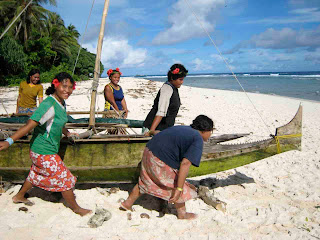
I am now leaving Tikopia and incredibly sad to do so, because the people are very nice there and because I haven’t really have had the chance to have a good look at the place. The weather has been too unreliable to be able to leave the KUNA unattended for more than a few hours. The anchorage on Tikopia looks nice and is nice provided the wind does not blow! Otherwise it inevitably blows in the wrong direction. Above, I wear the traditional Tapa cloth (made of tree bark) given to me as a going away present. Many pikininis were very curious to watch me scuba diving as I retrieved the mooring and detangled the chain.I was thankful to have light winds to do the job!

So here are a few stories and facts from my stay.

First, Tikopians are polynesians originating from Tonga and the above rock was believed by the ancients to be the petrified ship that brought their ancesters to the island..
Tikopia is a very remote island. I spent two weeks anchored with the KUNA while BBC crew were filming on Anuta island, 75 miles away. Very few yachts get to visit (10 in the last 8 years) and so my arrival was greeted by extreme excitement. When the kids saw me arriving in the yellow kayak, the were jumping laughing and screaming and I did not even have the chance to jump out that they were already carrying the kayak 30 m in the lagoon, in a big splash of water!

In less than 10 second, the Komodo, now a single kayak, was carried up the beach by 20 kids into a shady spot covered with leaves (one cockpit was removed and left in Lata to make space for more camera gear in the KUNA).

The kids learned very quickly how to unclip the break down paddles and while I went to visit the chief, a plethore of them stayed near the canoe. What an attraction!!

Everyday, at the time of my visit, they would gather on the beach to help. Here they are helping me crossing the canoe above one fish drive wall (a coral stone wall that helps them drive and catch the fish into a funnel where they place their nets or wait with spears)

On Tikopia, traditional dug out canoes are very valuable and the only mode of transport as no motor canoes are allowed on the island (chief order). The tikopian have enough building material to afford building canoe houses along the beach, to protect their canoe, and insisted I parked mine in too!!

With a single cockpit, I could not transport my crew Patrick onshore, so we even used some reliable pikinini to shuffle the canoe for us. He loved it and was very proud!

Only one or two resupply ship visit per year (if they are lucky) so Tikopians have no opportunity to spend money on petrol. Cash they have very little of anyhow, being so far from civilisation. So they use the wind, which is great on the flat waters of the sheltered side of the island. They also use their canoes in the lake and I would have like to go exploring there with the komodo but the heavy weather did not allow travelling far inthe exposed side of the lagoon
 The crater lake at Tikopia
The crater lake at TikopiaThe view of Tikopia from the air is an amazing one, see June 10th!
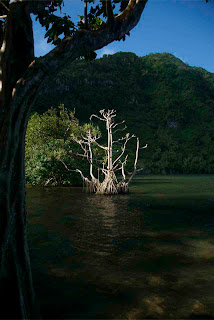
And it is also very pretty from the ground...

With my guide Ruby, a 14 year old girl which is quite adventurous and acting like a boy, to the point that I though she was one, I have had the chance to go and check the lake for half a day.

The lake takes almost one third of the island, nested in the crater and surrounded by steep cliffs on three sides. It can be accessed by going up and over the hill, through steep gardens full of mosquitoes (luckily, there is no malaria on Tikopia). A track follows around the lake, amongst the swamp taro and a few villages, to the sea. People fish in it and travel through to go to church or to their gardens. The google Earth photo is quite good and shows the lake just after the cyclone zoe in 2003, with the entrance broken open to the sea. The cyclone dramatically change the balance of the lake and affected a lot of people on the island.
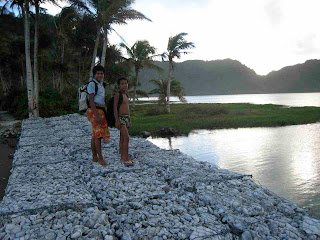
A new seawall has replaced the natural mount which separated the lake from the sea, destroyed by the cyclone. Thanks to an aid program and the visit of David Martin , wife Henriette and team aboard yacht Galatea. It is made of thick fencing wire around coral stones and prevents the seawater to enter the lake. Prior to the cyclone, the lake was mostly fresh though brackish waters and, after becoming salty, it is now slowly recovering back to its original chemistry.
Though the lake levels have been higher than before, it is not due to the design of the seawall. Historically, the lake has had one drain into the sea, maintained by the villagers, and it seems that the design of the drain has been modified by the lack of maintenance, causing the lake levels to raise.
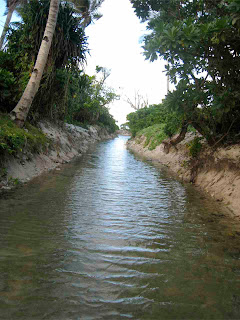
It is possible that the current generation is a little more lazy than their forefathers and failed to dig and maintain a drain wide enough to control the lake level. So does Chief Edward is telling me and he is quite keen for the people from his village (on the Northern side, where I am anchored) to walk over and help digging the drain, if food is prepared for them!
Visitors to the boatThe KUNA has become the object of daily visits from various people. Some like just to come and have a chat to Patrick, my crew from the Duff Islands. Patrick has been quite shy for going on the island and prefers staying on the boat most times. Good for me as I have the opportunity to go for short walks but I was finding it quite strange that I am feeling more at home amongst Tikopians than he is, although it is his own country! Surprisingly enough, Patrick also had a large group of pikininis following him along the beach when he went for visits. I though he would get away with it more than me, being black… Despite minor differences between Melanesian and Polynesian, overall, their lifestyle is very similar. Some visitors brought Patrick a spear so he could go fishing from the boat, and lets face it, he is in fact a good excuse for visitors to come and sit on the boat.

Patrick on the left and young Humphrey on the right
I have been allowing visitors onboard, some even for a cup of tea, as boat sitting at anchor is not very fun and it is nice to have conversation. It’s been OK most times except when a stuckload of pikininis jump onboard without asking permission, in which case they get put back into place. Unsolicited visits after a long night of anchor watching when I haven’t even had my coffee do not get a easy reception!! But generally things have been quite good except a bit of fishing gear going walkabout
Most people come with something to give us, a present which a few hours or the next day, turns into a trading object. The chief has forbidden villager to come to yachts asking for something but it seems all right for them to bring something and later organise some form of exchange so I ended up being able to trade vegetables from the island against fish hooks or other materials such as sand paper , hagsaw blades (for carvings).
The difficult thing is when people want something but are to shy to get to the point so hours of conversation are spent beating around the bush until the real motive for their visit comes out! It is ok when one has stacks of time but I had quite a bit of minor maintenance project to do like fixing the electric bilge pump, etc…
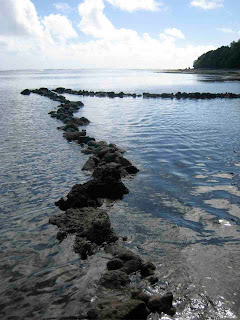
Although on an island, it has been hard to trade for fish or even catching it ourselves because of the large population on Tikopia. Around the anchorage, the waters are fished everyday and night and even the smallest fishes are caught. Above is a fish drive wall in the lagoon. The extremely clear waters around the anchorage were sadly depleted of big fish. Compared to Nupani, where the population is small, it was a desert!

Some fish with nets in the lagoon

One of many canoes line fishing around the KUNA
Communication and transport with TikopiaThe only means of communication with the island is HF radio, though for a few years, an HF email system was installed on a labtop. All being kept in the island clinic, safe from sand and rain. Sadly, the person who had some technical knowledge to manage the computer has left the island with his family, taking the community computer with him, so it was the end of email for Tikopia. When a government resupply ship only comes once or twice a year, it is hard for Tikopians to receive any mail. The odds of getting another email computer on the island are quite low. I tried to get their labtop onboard before leaving Lata but unsuccessfully. It is not just a matter of getting the gear there, but also having the technical knowledge at hand, on the island, to install and maintain the system so some islander would have to be sent to Honiara and trained for it, a costly and long process.
So I ended up trading emails for papaws and bananas.

The headmaster of the school on the other side and the chief were eager to get in touch with David Martin, the organizer of the aid project that fixed the seawall to ask for his news and if he would be coming back for further project. Cyclone Zoe has obviously changed spirits on Tikopia and placed this remote island on the “aid circuit”. Had it not happened (the cyclone that is), Tikopia would be barely known and people proudly self sufficient as Anutans are but the culture of aid seems to have brought people into the habit of asking and hoping for more aid projects to come in the future. Of course, external aid has been more useful than the inexistent Solomon island government support and some aid projects are good, provided they teach people how to help themselves and give them more independence. One example is the Lapita project led by Klaus Hympendahl with the support of James Wharram. Two catamarans are currently being built in the Phillipines for Tikopia and Anuta (see
www.lapita-voyage.org Tourism at TikopiaSometimes, some supplies come on tourist ships. Tourists ships? You may ask. yes Tikopia has been put on the trail of large cruising ships and as much as 8 ships a year pull in the anchorage for half a day or so. Meanwhile, the neighbouring island of Anuta, 75 miles away, gets none!
50 or more visitors then jump on the beach, get a tour of the village, to look at the custom dancing band, ready to demonstrate for them while the island carvers trade traditional weapons and dancing sticks with the tourists and they disappear as fast as they have appeared, not really getting to know anyone, which the tikopians seem a bit sad about. They seem to put up a good show, especially for them and the operation brings to the community between 2 and 7000 solomon dollars (for landing and shows). Tikopians have indeed become tourist savy, which explained the ludicrous anchoring fee of 500 solomon dollars I was asked when pulling up the first morning! Though it was a one off for my stay of two weeks and I was happy to confirm with the locals that it definitely goes to the Tikopia Development Fund. Selling artefacts to tourists is the only source of monetary income for Tikopians at the moment.

Money is generally not an issue as people are self sufficient for most things, except they need to pay for school fees for their children, especially those boarding for secondary school far away, 1000$ per year. Quite a few young tikopians told me not having finished their school years due to the lack of cash and they returned to their home to help their family and work in the gardens.

Gardens grow well on the steep cliffs of the island and provide a suprisingly varied staple to Tikopians: banana, papaw, pinapple, taro, yam, manioc (also called kassava), nally nuts, bush limes, bean, cabbage, eggplant, you name it! BUt the garden are often a long way from the villages and women travel a long way carrying heavy loads of food.

Few women get to leave the island and get an eduction beyond primary school as the priority is given to boys. With more men outside the island, there is an excess of young women on Tikopia. Most of them are quite shy, though, and very rarely I have had the chance to have a chat to them as the boys monopilize the attention and the guiding.

Anica is one of the teachers at the primary school and speaks fluent English but the teaching is also done in Pidgin and language. As most women on the island, she smokes a lot of locally grown tobacco. Cigarettes are not available here and islanders think they are full of chemical so prefer the home grown stuff. They often roll the tobacco in the pages from the notebooks, so if you donate some, make sure it goes to the teachers with the clear instruction that it is NOT for smoking!!!!
Cyclone-proof leaf houses!

Coconut and sago palm provide shelter and there are enough trees for large beams of the low roofed houses which are quite solidly built and capable of withstanding cyclonic winds.

view outside from a rather dark hut!

People live on the floor on nicely weaved sage and pandani mats, layers of tem cover the bare sand inside the houses and are constantly swept for food remains, cat hair and sand. The main house building is shared by the extended family, parents, their children and their own new born babies, all sleeping together in the one room until they build a house for their own family.

Here is a house under construction for a young family with a new born.

This one is the lounge that the young brother of the same family (21 years old) had built himself. Sharing the house with the entire family has a lack of privacy when it comes to chasing girls!! Though liaisons before marriage is never official on the island so the caves inside the cliffs of the eastern side are considered more appropriate

Tikopia eastern cliffs: rugged coastline in paradise!
The kitchenHouses which are too old are recycled and made into kitchens. The kitchen is a separate smaller house which has a big fire place inside, but no chimney. It is a rather challenging place to spend time in, as I have experienced. Peach dark, it is rapidly turned into a sauna and smoking room once the fire is started for “Mumuing” the food. Normally guests and men are not allowed into the kitchen as it is a dirty place, but one woman from the island who made friends with me, Cansy, invited me to look at how the food is prepared.
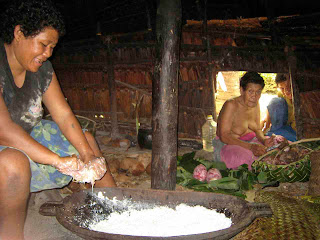

The Tikopian oven consists of making a large fire to heat volcanic stones. Taro, manioc, fish and coconut pudding are then wrapped into fresh leaves and placed under the stones, which are themselves covered with a large pile of leaves, some sewn together to make small blankets. It then looks like a giant bush turkey nest inside the kitchen! It takes many hours to cook the staple but the result is quite nice, much better than boiled. Apparently, food for the chief is only allowed to be prepared in the traditional way.

Here, some coconut puddings are prepared, a typical Tikopian dish which is pure coconut milk mixed with sago and cooked in the oven in the coconut shell. Yummy warm, though lacking the sweet taste that a westerner is used too but lethal the next day: my liver did not cope with the amount of coconut fat I was forced to politely ingest throughout the day and I was very tummy sick for a while!
A funeralIn their hospitable way, Tikopian had invited me to a festival and a traditional wedding but the weather did not allow me to join. There are 8 festival a year, one in each village, where the village band demonstrates to other visiting villages their dancing skills in traditional costumes of tapa cloth.
The last opportunity given to me was a funeral, to which I was invited, which gathered crowds from the entire island. I had the chance to join the ceremony where all crowds were gathered under the roof of the dead man’s family, gathering their voices in one single continuous humming sound. This lasted for two hours while hairs were being cut short, flowers passed around to decorate hair and ears and presents distributed between all. Then the eldest men of the family started some stumbling dances too: there was no space for them to put a foot between all the people sitting on the floor of the house. When a person dies, all relative and friends bring presents and prepare pudding, taro, etc . There was probably two tons of food piled up in coconut basket outside the dead man’s house, just a few meters from his grave, covered with a fresh coconut mat. After the ceremony, the food was shared and everyone went to eat LOTS but I returned to the KUNA, avoiding another feed of pudding!






